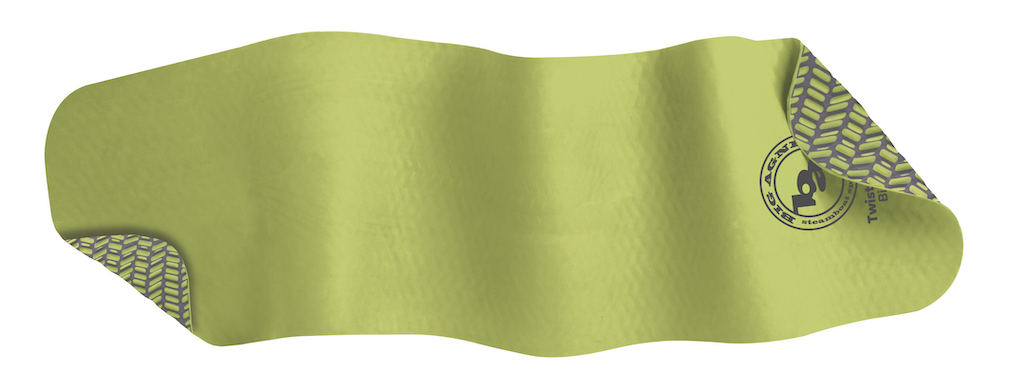Sourcing innovative materials to develop new products is often like cooking a recipe: Mix in a bulk of experience with a dash of luck and a pinch of detective work. When it all comes together, a new product is born. Five years ago, Tony Roina, the sourcing director for Big Agnes, had been searching for a more sustainable alternative to use in the closed-cell foam in sleeping pads since the traditional squishy ethylene-vinyl acetate (EVA) is damaging to the environment. Then, a sneaker company called Allbirds introduced a sugarcane-based foam in its shoes. Roina wanted to know more about how Big Agnes could use something similar in its sleeping pads. His sleuthing took him from the Big Agnes headquarters in Steamboat Springs, Colorado, to a sugarcane farm in Brazil.
The result: a sweet solution for cushioned comfort. The key ingredient: a bio-based foam derived from sugarcane resin, called TwisterCane™ BioFoam. Big Agnes is the first to bring this particular EVA replacement into the camping world with its new sleeping pad and seat, which slash ounces while also lessening the brand’s carbon footprint compared to petroleum-based products.
“We’re trying to take small steps to change materials and make our products more sustainable to foster a better relationship with the environment,” says Roina. Big Agnes started using solution-dyed fabric in its tents in 2021, a coloring process that reduces water and energy consumption during manufacturing. All of its down is Responsible Down Standard Certified, and the brand launched a Re-Routt™ collection in 2008 that highlights products constructed with recycled materials.

Next up: one of the more ubiquitous materials in the outdoor world. First popularized in the 1970s by fitness giant Nike, EVA is commonly used in the midsole of running and hiking footwear. Some consider it a ‘Goldilocks’ material: It still retains its shape but squishes juuust enough to be comfortable. For this reason, it is also a staple material in sleeping pads, adding both cushion and warmth for those sleeping on the ground. Alternative technologies continue to evolve, but EVA is still widely used throughout the camping and footwear industries.
But there is a catch: EVA isn’t the greenest stuff out there. First, one of the main polymers that creates EVA comes from petrochemicals, or chemicals directly derived from petroleum and fossil fuels, which account for a large chunk of planet-warming greenhouse gas emissions. (In addition to EVA, lots of outdoor apparel and equipment, from fleece jackets to nylon tent walls and synthetic base layers, have some type of origin story in petrochemicals.) But it gets worse with EVA’s end-of-life complications. When EVA foam is thrown into landfills, it can take hundreds of years to naturally degrade (most believe bio-based foams will break down much quicker). And as the foam does breakdown, it releases harmful volatile organic compounds (VOCs) into the environment, which leach into groundwater and rivers and contribute to the tropospheric ozone, a major component of smog that triggers health problems and is harmful to plants and wildlife.
That is a lot of science, but the takeaway is clear: less petroleum-based EVA in the world is one way to reduce some of the harmful impacts from fossil fuels.
In 2019, Big Agnes found a solution in Brazil, the world’s largest sugarcane producer. Sugarcane is a stalky grass that is grown and harvested to produce, you know, sugar, but one byproduct of that refining process is sugarcane resin. Big Agnes worked with a Brazilian company that had learned how to substitute in sugarcane resin for petrochemical resin. They transformed that sugarcane resin into pellets to make bio-based ethylene, which they used to create an EVA foam that uses 60%-70% bio-based materials. The remaining 30%-40% is still constructed with a vinyl acetate to act as the crosslinking agent that holds everything together. There are other environmental benefits to using sugarcane resin. Like any plant, sugarcane absorbs carbon dioxide, and harvesting sugarcane is a carbon neutral process.

End results: the TwisterCane™ BioFoam sleeping pad, made from more than 60% sugarcane resin in place of the stuff that comes from petroleum. At a half-inch thick and weighing 14 ounces, the mats are built for ultralight backpacking adventures to stay aligned with Big Agnes’ core audience and ethos. It has a relatively low R-value (1.7), which corresponds to its ability to resist heat loss from the ground, so it’s best suited for warmer temperatures. “This mat is great,” says one REI Co-op member. “I swear, I won’t sleep without it.”
But here’s the million-dollar question: Is this “sugar foam” the way of the future? While he won’t disclose any specifics, Roina says that Big Agnes is working on additional applications for the bio-based foam. Plenty of brands are using it in the midsoles of footwear, and sugarcane itself is making appearances in products like technical ski gear by Picture Organic Clothing and emergency fire starters like the UCO Stormproof Sweetfire Starter Points.
It’s a complicated recipe to mix together a variety of suppliers, industries and technologies, but Roina enjoys the challenge of bringing innovative and sustainable materials to hikers and backpackers. “Any time we can get petrochemicals out of our products, that’s a good thing,” he says. “Whenever we find a material with less of a carbon impact, we are going to give it a try.”
